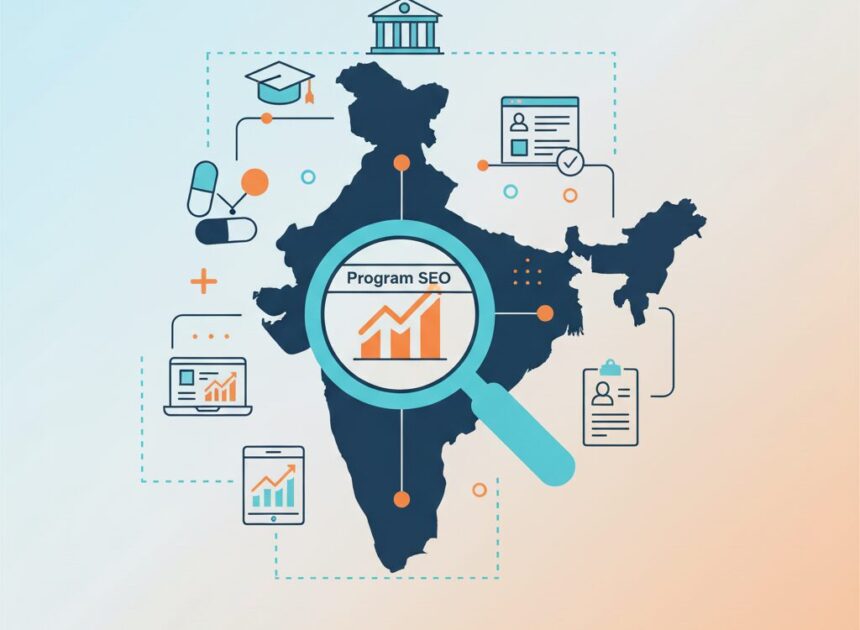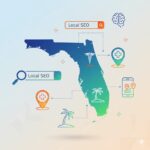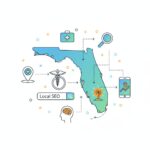The competition for student admissions in India is more intense than ever before. For every available seat in a sought-after program, there are hundreds, if not thousands, of applicants. Today, the journey to that seat doesn’t start with a campus visit; it starts with a search query. Prospective students across the country are typing specific, high-intent phrases into Google, like “MCA course admission eligibility,” “best B.Tech CSE colleges in India,” or “MBA in marketing fees.”
The single most important digital asset in capturing this traffic is your program page (i.e., your course page). Yet, for many Indian colleges, universities, and coaching institutes, these pages are little more than digital brochures. Optimizing them for search—with clear career outcomes, detailed eligibility criteria, FAQs, and compelling application CTAs—is the key to improving organic visibility and driving a steady stream of qualified applications. This post provides a complete, ready-to-use blueprint for transforming your program pages into powerful student acquisition engines.
The Ultimate Program Page Blueprint (Must-Have Elements)
A high-converting program page must answer every question a prospective student (and their parents) might have. It needs to be comprehensive, persuasive, and structured for scannability. Think of each element as a crucial piece of your digital admissions pitch.
1. Compelling Course Overview
This is your opening statement. Go beyond a dry, academic description. Start with a hook that addresses a student’s career aspirations. Explain what the program is, who it’s for, and the unique opportunities it offers. Naturally weave in your primary and secondary keywords, such as the course name, “degree,” “admission,” and your institution’s location.
2. Crystal-Clear Eligibility and Admission Process
Ambiguity is a conversion killer. Clearly list all eligibility requirements (e.g., 10+2 percentage, required subjects, entrance exam scores). Provide a step-by-step timeline for the admission process, including application deadlines, entrance test dates, and interview schedules. This transparency pre-qualifies applicants and reduces the burden on your admissions office.
3. Detailed Syllabus Highlights
While you should link to the full syllabus PDF, the page itself should feature a summary of key subjects, modules, or specializations. Use an accordion or tabbed layout to keep the design clean. This is an excellent place to include LSI keywords related to specific subjects (e.g., “machine learning,” “data structures,” “corporate finance”) that students might be searching for.
4. Esteemed Faculty Profiles
For higher education, expertise is a key selling point. Showcase the faculty for the program. Include their photos, qualifications, specializations, and links to their research publications or professional profiles. This is a powerful way to demonstrate E-A-T (Expertise, Authoritativeness, Trustworthiness), a critical factor in Higher Education SEO.
5. Tangible Career Outcomes and Placement Details
For Indian students and their families, the ultimate question is: “What are the job prospects?” This section is arguably the most important on the page.
- Placement Statistics: Include data on placement rates, average and highest salary packages, and top recruiting companies.
- Company Logos: A visual wall of logos from well-known companies that have hired your graduates is powerful social proof.
- Alumni Testimonials: Feature short quotes or video testimonials from successful alumni who describe how the program shaped their careers. This directly addresses the crucial program outcomes that students are looking for.
6. Transparent Fee Structure and Scholarship Information
Be upfront about the complete fee structure, including tuition, hostel fees, and any other charges. More importantly, dedicate a section to available scholarships, grants, and financial aid options. A page that helps students find ways to afford their education is a page that converts. This is essential for capturing scholarship search queries.
7. A Clear and Unmistakable Application CTA
Your page must have a clear, prominent Call-to-Action (CTA) button, such as “Apply Now” or “Download Prospectus.” Place it high on the page (above the fold) and repeat it at the end, ensuring a student never has to hunt for the next step.
On-Page SEO Elements for Maximum Visibility
A great structure needs to be supported by technical on-page SEO to ensure it ranks. Effective course page SEO relies on getting these details right.
Perfect Your Title Tag Structure
The title tag is a powerful ranking signal. It should be clear, concise, and compelling.
- Proven Formula:
[Program Name] Admission [Year] - [Institution Name], India | Apply - Example:
MSc Computer Science Admission 2026 - [College Name], India | Apply Now
Use FAQ Schema for Common Admission Questions
Anticipate and answer the most common questions your admissions team receives. Then, mark up this content with FAQ schema. This can help you win a large, eye-catching rich snippet in Google’s search results.
- Example Questions for your admissions FAQ:
- “What is the last date to apply for the BBA program?”
- “Is there a hostel facility available on campus?”
- “What entrance exams are accepted for MBA admission?”
PPL Keywords for Paid Student Lead-Gen
While organic SEO builds a long-term asset, Pay-Per-Lead (PPL) or PPC campaigns can drive immediate applications during peak admission season. Target high-intent, transactional keywords where the searcher is ready to take action.
MBA admission 2025 Mumbaiengineering college admission DelhiBSc nursing course application India
These keywords should lead to dedicated landing pages with a prominent lead form, highlighting key dates, scholarship offers, or a “Download Prospectus” CTA to capture leads effectively.
Internal Linking for Authority and Conversions
A well-planned internal linking structure guides both students and search engines to your most important pages. A scattered approach to SEO for educational institutions will dilute your authority.
Think of your website in a “hub-and-spoke” model. A central “Faculty of Science” page (the hub) should link out to all the specific program pages like BSc Physics, MSc Chemistry, etc. (the spokes). In turn, these program pages should link back to the main faculty hub and, most importantly, to the central admissions and application forms. This consolidated structure builds topical authority and creates clear conversion pathways. As technology evolves, understanding the Future of SEO with AI: GEO, Google AI Overviews & 2025 Trends will also be key to personalizing these user journeys on your site.
The Final Step: From Page to Application
Your program pages are the most valuable real estate on your institution’s website. By transforming them from static brochures into comprehensive, SEO-optimized resources, you meet prospective students exactly where they are in their journey. You provide the answers they need, build trust in your institution, and create a seamless path from search query to submitted application.







